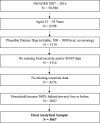Associations between Food Insecurity and Supplemental Nutrition Assistance Program (SNAP) participation with ultra-processed food intake in lower-income U.S. adolescents
- PMID: 40568620
- PMCID: PMC12187485
- DOI: 10.1017/jns.2025.24
Associations between Food Insecurity and Supplemental Nutrition Assistance Program (SNAP) participation with ultra-processed food intake in lower-income U.S. adolescents
Abstract
Ultra-processed foods (UPFs) have negative health consequences. Food insecurity and Supplemental Nutrition Assistance Program (SNAP) are associated with higher UPF intake in U.S. adults, but this has not been examined in U.S. adolescents. This study assesses associations between food security status and SNAP participation with UPF intake in 3,067 adolescents aged 12-19 years with household incomes at or below 300% of the federal poverty line from the 2007-2016 National Health and Nutrition Examination Survey. UPF is defined using the Nova classification and measured as a percentage of daily total energy intake (TEI). High food security, marginal food security, or food insecurity status was determined through the U.S. Department of Agriculture's eighteen-item Household Food Security Survey. SNAP participation was deemed affirmative if the household reported receiving SNAP benefits in the last year. Multivariable linear regressions that controlled for TEI and sociodemographic covariates and accounted for the complex survey design examined associations between food insecurity and SNAP participation with UPF intake. In the sample, the prevalence of marginal food security was 15.9%, the prevalence of food insecurity was 33.8%, and the prevalence of SNAP participation was 36.5%. After multivariate adjustment, there were no significant differences in UPF intake by food security status. Adolescents participating in SNAP consumed 2.7% higher UPF intake (95% CI: 0.1%, 5.2%, p = 0.04) compared to adolescents not participating in SNAP. Among lower-income U.S. adolescents, SNAP participation but not food security status was associated with higher UPF intake. Programs and policies promoting the intake of more healthful, minimally processed foods should be strengthened.
Keywords: Adolescents; Food security; Supplemental nutrition assistance program (SNAP); Ultra-processed foods (UPF).
© The Author(s) 2025.
Conflict of interest statement
JML is on the Medical Advisory Board for GoodRx, served as a consultant to Tandem Diabetes Care, and participated on the Sanofi Digital Advisory Board. APF, AB, JAW, EMS, and CWL — none.
Figures
Similar articles
-
Food insecurity and ultra-processed food consumption in the Health and Retirement Study: Cross-sectional analysis.J Nutr Health Aging. 2025 Feb;29(2):100422. doi: 10.1016/j.jnha.2024.100422. Epub 2025 Jan 7. J Nutr Health Aging. 2025. PMID: 39778268 Free PMC article.
-
Changes in Food Insecurity Among US Adults With Low Income During the COVID-19 Pandemic.JAMA Netw Open. 2025 Feb 3;8(2):e2462277. doi: 10.1001/jamanetworkopen.2024.62277. JAMA Netw Open. 2025. PMID: 40019759 Free PMC article.
-
Association Between Ultra-processed Food Consumption and Mortality Among US Adults: Prospective Cohort Study of the National Health and Nutrition Examination Survey, 2003-2008.J Acad Nutr Diet. 2025 Jul;125(7):875-887.e7. doi: 10.1016/j.jand.2024.11.014. Epub 2024 Nov 26. J Acad Nutr Diet. 2025. PMID: 39608567
-
Who consumes ultra-processed food? A systematic review of sociodemographic determinants of ultra-processed food consumption from nationally representative samples.Nutr Res Rev. 2024 Dec;37(2):416-456. doi: 10.1017/S0954422423000240. Epub 2023 Oct 31. Nutr Res Rev. 2024. PMID: 37905428 Free PMC article.
-
Beyond Food Assistance: A Scoping Review Examining Associations of Nonfood Social Safety Net Programs in the United States With Food Insecurity and Nutrition Outcomes.Nutr Rev. 2025 Jul 1;83(7):1344-1357. doi: 10.1093/nutrit/nuae216. Nutr Rev. 2025. PMID: 39868761
References
-
- Juul F, Vaidean G, Lin Y, Deierlein AL, Parekh N. Ultra-processed foods and incident cardiovascular disease in the Framingham offspring study. J Am Coll Cardiol. 2021;77(12):1520–1531. - PubMed
MeSH terms
LinkOut - more resources
Full Text Sources


